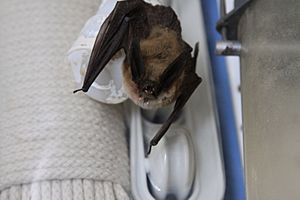Long-eared myotis facts for kids
Quick facts for kids Long-eared myotis |
|
|---|---|
 |
|
| Conservation status | |
| Scientific classification | |
 |
|
| Range of the long-eared myotis | |
| Synonyms | |
|
The long-eared myotis (Myotis evotis) is a small, pale brown bat with very long ears. It is a type of vesper bat, which are common bats found worldwide. You can find this bat living in western Canada, the western United States, and Baja California in Mexico.
Contents
What Does the Long-Eared Myotis Look Like?
The long-eared myotis has fur that is usually pale brown or straw-colored. Its ears and the skin of its wings are black. The bat's face is also black. Bats found near the coast often have darker fur. These darker bats are a special type called Myotis evotis pacificus.
Where Do Long-Eared Myotis Live?
The long-eared myotis lives in many different places. These include dry shrublands, grassy plains, and mountain forests. They can live from sea level up to about 2,830 meters (9,285 feet) high.
Favorite Roosting Spots
These bats like to rest and sleep in various safe spots. They use tree holes, cracks in rocks, caves, and even old, empty buildings. They seem to like rock cracks the most. In the northern parts of their home range, they often choose ponderosa and lodgepole pine trees.
Female bats, especially when they are raising young, often roost in small, narrow cracks. These cracks are usually about 2 centimeters (0.8 inches) wide and go straight up. They often have a small overhang above the opening.
Moving to New Roosts
Sometimes, a whole group of long-eared myotis bats will move to a new roosting spot. These new spots often have lots of rocks for cover. They are usually far from water and do not have many trees or much grass nearby.
How Do Long-Eared Myotis Behave?
The long-eared myotis is an insectivore, meaning it eats insects. It is especially good at hunting beetles. This bat has strong teeth and a special jaw structure. This allows it to crush the hard outer shells of beetles.
Hunting for Food
The long-eared myotis hunts in two main ways:
- Gleaning: This is when the bat picks insects off the ground or from trees.
- Aerial-hawking: This is when the bat catches insects while flying in the air.
When flying and hunting, these bats use echolocation. This means they send out sounds and listen for the echoes to find their prey. When they are gleaning (picking insects off surfaces), they use echolocation less often. This is because making echolocation calls uses a lot of energy.
See also
 In Spanish: Myotis evotis para niños
In Spanish: Myotis evotis para niños


